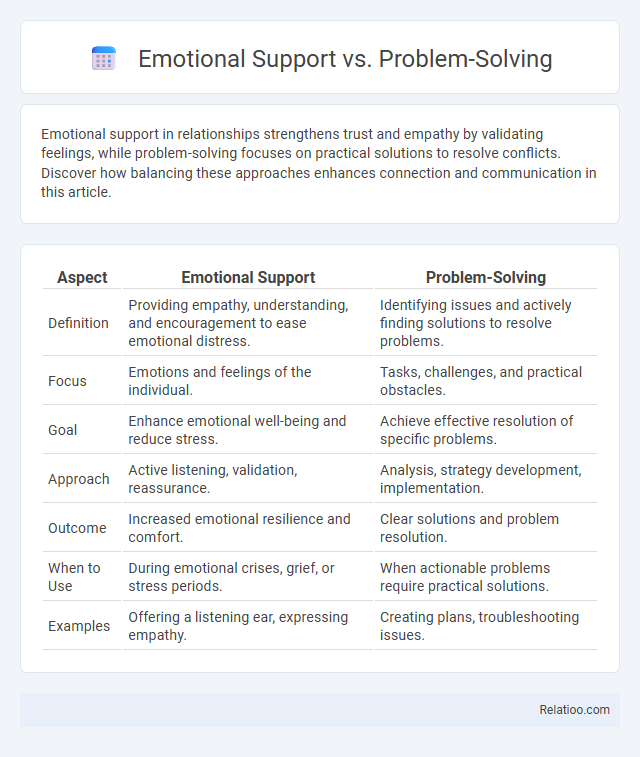Emotional support in relationships strengthens trust and empathy by validating feelings, while problem-solving focuses on practical solutions to resolve conflicts. Discover how balancing these approaches enhances connection and communication in this article.
Table of Comparison
| Aspect | Emotional Support | Problem-Solving |
|---|---|---|
| Definition | Providing empathy, understanding, and encouragement to ease emotional distress. | Identifying issues and actively finding solutions to resolve problems. |
| Focus | Emotions and feelings of the individual. | Tasks, challenges, and practical obstacles. |
| Goal | Enhance emotional well-being and reduce stress. | Achieve effective resolution of specific problems. |
| Approach | Active listening, validation, reassurance. | Analysis, strategy development, implementation. |
| Outcome | Increased emotional resilience and comfort. | Clear solutions and problem resolution. |
| When to Use | During emotional crises, grief, or stress periods. | When actionable problems require practical solutions. |
| Examples | Offering a listening ear, expressing empathy. | Creating plans, troubleshooting issues. |
Understanding Emotional Support
Understanding emotional support involves recognizing its role in providing comfort and validation without immediately offering solutions, allowing you to feel heard and valued. Unlike problem-solving, which centers on finding practical answers to challenges, emotional support prioritizes empathy and connection to ease emotional distress. Expressiveness enhances emotional support by encouraging open sharing of feelings, fostering deeper interpersonal bonds and resilience.
Defining Problem-Solving Approaches
Problem-solving approaches involve identifying a challenge, analyzing potential solutions, and implementing strategies to resolve the issue effectively. These methods prioritize logical thinking and goal-oriented actions to achieve tangible outcomes. Your ability to apply structured problem-solving techniques can enhance decision-making and increase success in overcoming obstacles.
Key Differences Between Emotional Support and Problem-Solving
Emotional support focuses on validating Your feelings and providing comfort, while problem-solving emphasizes identifying issues and finding practical solutions. Expressiveness involves openly sharing emotions and thoughts, which can enhance emotional support by fostering understanding. The key difference lies in emotional support addressing Your emotional well-being, whereas problem-solving targets resolving external challenges.
When to Offer Emotional Support
Emotional support is most effective when someone is experiencing distress or vulnerability and needs empathy and understanding rather than advice or solutions. Offering emotional support helps validate feelings and fosters connection, especially during times of grief, anxiety, or personal challenges. Recognizing cues like emotional overwhelm or a desire to be heard signals the appropriate moment to prioritize empathy over problem-solving or expressiveness.
When to Focus on Problem-Solving
When navigating interpersonal challenges, focusing on problem-solving is essential if the issue is clear, actionable, and requires a practical solution to improve your situation. You should prioritize problem-solving when the goal is to address specific obstacles, implement strategies, or make decisions that can lead to measurable progress. This approach helps shift the conversation from emotional venting to tangible outcomes, ensuring resolution and forward movement.
The Role of Active Listening
Active listening serves as a crucial element in emotional support, problem-solving, and expressiveness by fostering understanding and validating feelings. In emotional support, active listening helps individuals feel heard and emotionally connected, while in problem-solving, it clarifies concerns and facilitates effective solutions. For expressiveness, active listening encourages open communication and authentic sharing of thoughts, enhancing relational depth and trust.
Emotional Support in Relationships
Emotional support in relationships involves providing empathy, understanding, and reassurance, which strengthens trust and emotional connection between partners. It plays a critical role in enhancing relationship satisfaction by validating feelings and reducing stress. Unlike problem-solving or expressiveness, emotional support focuses on comforting rather than fixing issues or solely sharing thoughts.
Enhancing Problem-Solving Skills
Enhancing problem-solving skills involves balancing emotional support, problem-solving strategies, and expressiveness to improve cognitive processing and decision-making. Emotional support creates a safe environment that reduces stress and increases motivation, enabling clearer thinking and more effective solutions. Expressiveness fosters open communication, facilitating the exchange of ideas and collaboration necessary for innovative problem-solving approaches.
Balancing Empathy and Solutions
Balancing empathy and solutions requires understanding the distinct roles of emotional support, problem-solving, and expressiveness in communication. Emotional support fosters a safe space for Your feelings, emphasizing validation and active listening, while problem-solving directs attention to practical steps and resolutions. Expressiveness bridges both by conveying emotions authentically, allowing empathy to coexist with strategic thinking for effective interpersonal interactions.
Choosing the Right Approach for Each Situation
Selecting the appropriate approach--emotional support, problem-solving, or expressiveness--depends on the specific context and individual needs. Emotional support is most effective during times of distress when empathy and validation are crucial, while problem-solving suits situations requiring practical solutions and actionable steps. Expressiveness helps in clarifying feelings and fostering open communication, enabling better understanding and tailored responses.

Infographic: Emotional Support vs Problem-Solving
 relatioo.com
relatioo.com